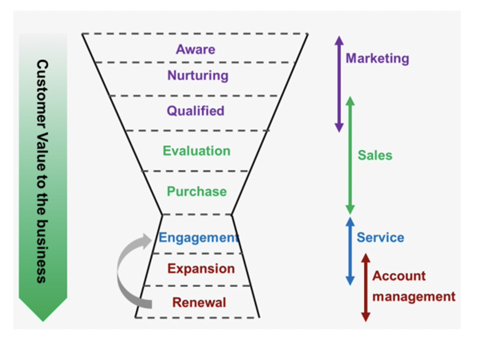Foundations of B2B SAAS Marketing - Part 1
B2B SaaS marketing, it’s a busy industry to be in.
Much of our time is spent driving strategies and thought leadership for our target market, leaving little room to keep up with the essentials and innovations that drive our own marketing and industry forward.
I believe in the importance of taking a step back, when possible, and familiarising ourselves with our industry and audience.
In doing so, we can better understand the end-users landscape, enabling us to clearly identify the problems we are solving for end-users, and articulate our proposition in a way that supports them. In the process, we are making the decision-making journey as straightforward as possible, benefitting both consumers and businesses alike.
In the first of this two-part blog series, I’ll be taking you through the basics of B2B SaaS marketing. Our landscape, our buyers, and the journey they typically take.
Let’s get started!
B2C vs B2B
I want to begin at the very foundation of our industry by covering some of the basic differences between B2C (Business-to-Consumer) and B2B (Business-to-Business) marketing.
One primary difference between the two approaches is their target audiences. B2C marketing focuses on the individual consumer, often with the aim to appeal to their emotions and personal needs.
In contrast, B2B marketing targets businesses and their associated professionals. This approach will focus on addressing organisational needs, requirements, and challenges.
These differences heavily influence the decision-making process. B2C purchases are usually driven by more personal desires, which can result in impulse or immediate needs, and therefore a shorter, more straightforward customer journey.
B2B purchases are more complex. Involving a longer decision-making process, various stakeholders, and a greater focus on return on investment and budgets.
Despite their differences, both approaches aim to generate positive brand awareness, drive sales, and build a loyal customer base. All of which is essential to the customer journey, no matter what the sector.
Understanding the B2B SaaS landscape
The growth of the B2B SaaS industry is staggering.
The global SaaS market size is expected to reach USD 819.23 billion by 2030, growing at a CAGR of 13.7% from 2023 to 2030.
And according to Scott Brinker, a renowned martech expert, the number of martech solutions alone has grown to 11,038. Increasing by roughly 1,000 over the past year and representing a 7,000% growth in the space over the last 12 years.
In a nutshell, this means that the B2B SaaS landscape is a highly competitive place to be.
Whilst the growth in solutions is indeed exciting for businesses and consumers alike, it also poses a daunting task when it comes to evaluating and selecting the right tools for their specific needs. With 6 in 10 business decision-makers stating they experience 'decision paralysis' during the process.
This is exacerbated by the increasing complexity of the landscape, with each solution boasting its own unique features, capabilities, and compatibilities. Making it difficult for businesses to determine which ones are essential, and how they fit into their overall marketing strategy.
B2B SaaS customers
Furthermore, the typical researcher and buyer within the landscape has changed over recent years.
Roughly 73% of those who participate in B2B buyer research and decision-making are millennials. And unsurprisingly, they are bringing their personal purchasing habits with them.
Typically, this buying behaviour involves spending more time using social media to research vendors and solutions, relying more on peer recommendations and review sites, and engaging heavily with video marketing.
It’s worth noting that a considerable 48% of B2B purchase decision-makers report finding B2B advertising boring, and 81% of B2B buyers believe they’d make better decisions if B2B advertising did a better job of engaging them.
Whilst initially daunting, this poses a great opportunity for B2B SaaS marketers to gain a fuller understanding of modern purchasers; their behaviours, influences, and attitudes, to ensure impactful activity.
The 5 stages of the buying journey
Let’s move onto the buying journey that typical B2B SaaS purchasers navigate through when considering and ultimately purchasing a solution.
Understanding these stages is crucial for businesses to effectively target, market, and sell their solutions.
There are different variations of buying journeys for all sectors, however for B2B SaaS, I find the below most useful:

Source: https://www.saasworthy.com/blog/a-comprehensive-guide-to-master-saas-sales
1. Awareness
At this stage, potential buyers become aware of a problem or a need within their business that can be addressed by a SaaS solution. They will start researching and gathering information about available options, which means branding is essential.
That’s because depending on your industry, roughly 20% of your target market will be in a buying cycle. However, it’s brand awareness that will influence the remaining 80% of your audience when they are next in the market for a solution.
2. Consideration
In the consideration stage, buyers evaluate different SaaS providers and solutions that align with their requirements. They compare features, pricing, customer reviews, and case studies to determine which options are most suitable.
Notably, 41% of B2B buyers read at least 3 pieces of content during this stage. And almost 70% of B2B buyers find and digest content directly from a vendor’s website.
3. Decision
In this stage, buyers narrow down their choices to a few vendors and make their final decision. They will often request demos, engage in discussions with sales and customer service departments, and assess the overall value proposition of each solution.
4. Implementation
After selecting a SaaS provider, the implementation stage begins.
The buyer will work closely with the vendor to set up and configure the software, integrate it with existing systems, and train their team on how to effectively use the solution.
At this stage, how-to-guides, troubleshooting content, and workshops will prove useful for the customer to get up and running.
5. Adoption and renewal
Once the SaaS solution is implemented, the buyer's focus shifts to adoption and achieving their goals. Ideally, the vendor provides ongoing support, training, and updates to ensure customer success. Alongside marketing initiatives to keep the customer engaged and loyal.
At the end of the subscription period, the buyer decides whether to renew the contract based on their satisfaction with the solution's performance, and ultimately their relationship with the business.
What’s next?
Part 1 of this blog series has focused on ensuring a solid understanding of how B2B SaaS marketing works, and the landscape which informs this.
In part two we’re going to dive into the ‘how to’ of this process. Understanding and presenting your brand, monitoring competitor activity, and the development of your ICP (ideal customer profile).
Keep your eyes peeled for part 2, coming soon!

Photo by Camille Brodard on Unsplash

 How to resolve AdBlock issue?
How to resolve AdBlock issue? 
